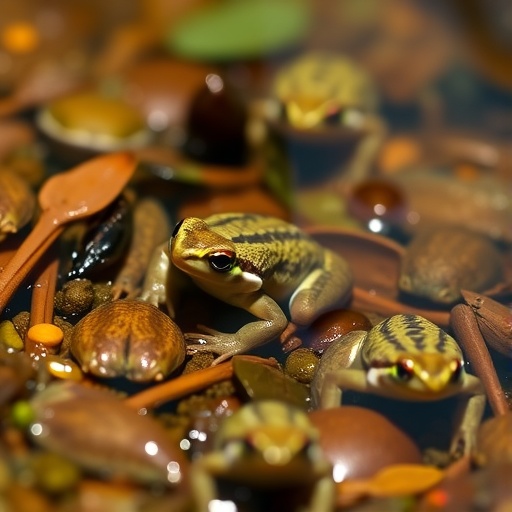In recent years, environmental science has increasingly emphasized the critical importance of conserving biodiversity and protecting habitats to sustain ecosystem health. A groundbreaking study published in Environmental Science and Pollution Research highlights the significance of protected core areas in preserving the health of amphibian populations, specifically focusing on the tadpoles of Aplastodiscus perviridis. This species, native to the Brazilian Atlantic Forest, serves as an exemplary case for understanding the broader implications of habitat conservation.
The study, spearheaded by a collaborative team of researchers including C.E.M. Bagnolo, A. Pompermaier, and B.M.S. Sergio, meticulously documents the health metrics of tadpoles residing within protected areas compared to those in unprotected environments. The findings are particularly compelling, as they reveal that protected core areas provide not only a safe haven for these vulnerable amphibians but also ensure a robust ecosystem that promotes their overall health. The researchers employed a multi-faceted approach that combined field observations with laboratory analyses to assess the physiological conditions of the tadpoles.
Among the various health indicators evaluated, the researchers primarily focused on growth rates, immune responses, and susceptibility to disease. These factors are crucial as they directly affect the survival and reproductive success of tadpole populations. The data revealed that tadpoles inhabiting protected zones exhibited significantly enhanced growth rates and a stronger immune response compared to their counterparts from unprotected sites. This stark contrast underscores the critical role of habitat quality in influencing amphibian health.
Moreover, the study investigated the environmental variables that contribute to the favorable conditions found in protected core areas. Factors such as temperature stability, water quality, and the absence of pollutants were identified as key elements that bolster tadpole health. The researchers noted that these parameters create an ideal environment for Aplastodiscus perviridis, allowing them to thrive and successfully develop into adult frogs. The absence of anthropogenic pressures, such as urban development and agricultural runoff, further contributes to the overall ecosystem integrity within these protected zones.
One of the most pressing issues highlighted by the research team is the ongoing threat of habitat destruction due to deforestation, climate change, and pollution. These threats not only jeopardize the health of amphibian populations but also disrupt the delicate balance of the ecosystems they inhabit. As one of the most imperiled groups of wildlife on the planet, amphibians serve as vital indicators of environmental health. Their decline can signal broader ecological consequences that may affect numerous other species, including humans.
In emphasizing the importance of necrobiotic progression, the researchers suggest that maintaining and expanding protected core areas could have profound implications for biodiversity conservation. Habitats that are safeguarded from human interference provide ecological refuges where species can adapt and flourish, even in the face of environmental changes. The authors advocate for increased efforts to establish additional protected areas throughout Brazil’s Atlantic Forest, a region teeming with unique biodiversity yet facing unprecedented levels of threat.
The scientists also raise awareness about the significance of community engagement in conservation efforts. Local communities play an essential role in the success of protected areas by participating in monitoring programs and promoting sustainable practices. By fostering social investment in conservation, they can enhance the long-term viability of protected environments, creating a symbiotic relationship between humans and nature.
Accompanying this study, visual documentation emphasizes the striking beauty of Aplastodiscus perviridis within its natural habitat. Such images evoke a sense of urgency to protect these ecosystems, showcasing the creatures that contribute to the rich tapestry of life on our planet. The emotional appeal is further magnified by highlighting the unique ecological roles that these amphibians fulfill, including pest control and nutrient cycling.
In light of the compelling evidence presented, the researchers have called upon policymakers to prioritize habitat conservation as a crucial element of biodiversity strategies. Legislative frameworks that support the establishment and enforcement of protected areas can serve as powerful tools in reversing the trends of habitat degradation. The study makes a persuasive case for the integration of scientific research with policy-making to ensure the resilience of amphibian populations and the ecosystems they inhabit.
As scientists continue to unravel the interactions within these ecosystems, the imperative for interdisciplinary collaboration becomes evident. Ecologists, conservationists, and policymakers must work hand in hand to foster environments that protect vulnerable species and maintain ecological balance. Collaborative approaches that combine the expertise of a diverse range of stakeholders will be essential in developing effective conservation strategies.
In conclusion, the findings from this research spotlight the pivotal role that protected core areas play in safeguarding the health of amphibian populations, specifically the tadpoles of Aplastodiscus perviridis. As global biodiversity faces unprecedented challenges, the lessons learned from this study serve as a clarion call for urgent action. Protecting habitats is not just about conserving individual species; it is about preserving the intricate web of life that sustains our planet. The future of amphibians, and indeed the health of our ecosystems, hangs in the balance.
The implications of this research extend far beyond the realm of amphibian health. They resonate with a broader message about environmental stewardship and the interconnectedness of all living organisms. By protecting our natural resources and ensuring the resilience of ecosystems, we are ultimately safeguarding our own future on this planet.
Subject of Research: Conservation of amphibian health in protected areas
Article Title: Protected core areas safeguard tadpole health: Evidence from Aplastodiscus perviridis in a Brazilian Atlantic Forest Reserve.
Article References:
Bagnolo, C.E.M., Pompermaier, A., Sergio, B.M.S. et al. Protected core areas safeguard tadpole health: Evidence from Aplastodiscus perviridis in a Brazilian Atlantic Forest Reserve.
Environ Sci Pollut Res (2025). https://doi.org/10.1007/s11356-025-37073-0
Image Credits: AI Generated
DOI:
Keywords: Amphibian conservation, habitat protection, biodiversity, Aplastodiscus perviridis, environmental health, Brazilian Atlantic Forest, ecological integrity, community engagement.




